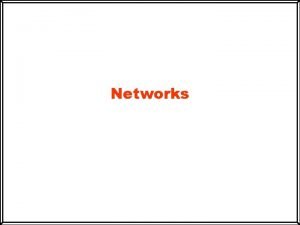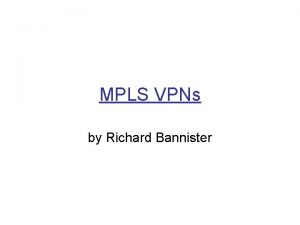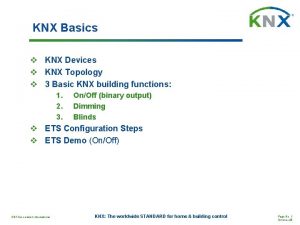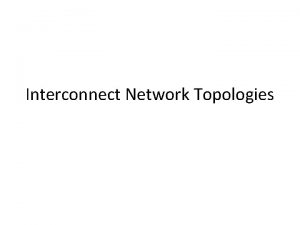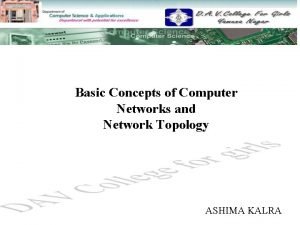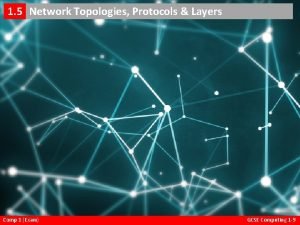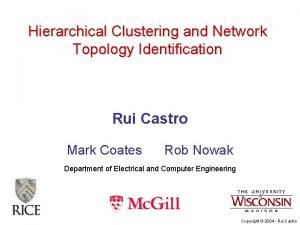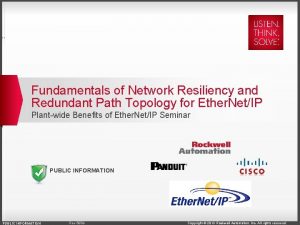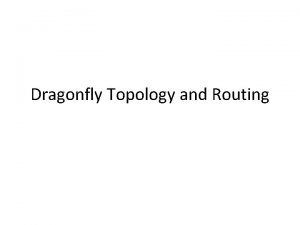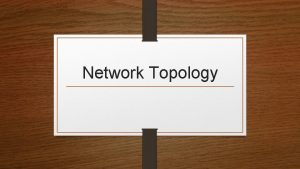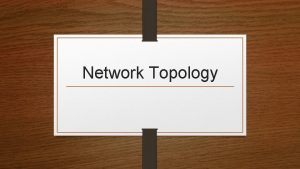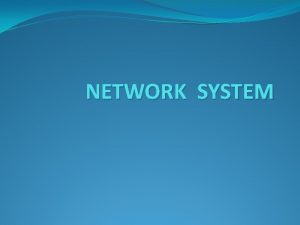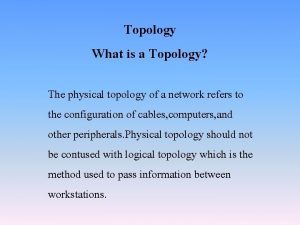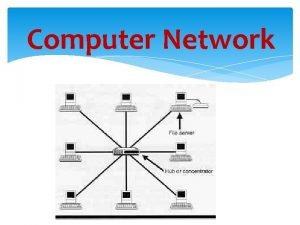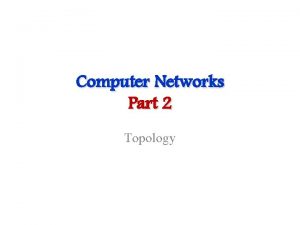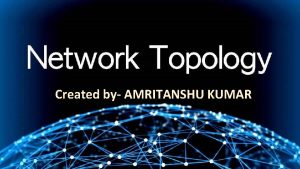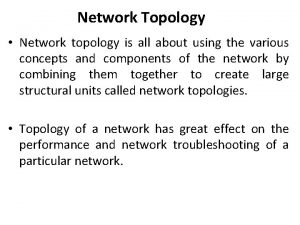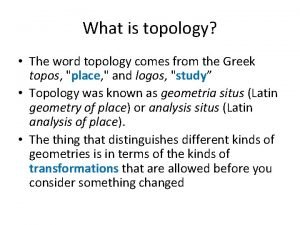Network Topology Name Duaa Alfadhli ID 200800919 Section
















- Slides: 16

Network Topology Name: Dua'a Alfadhli ID: 200800919 Section: 201 Instructor: Mohammed Rafiq

Introduction: • Topology: represents the arrangement of network and the way computers are connected to each other • two types of network topology; physical topology and logical topology. • The logical topology has eight essential topologies; the Point–to–point, Bus, Star, Ring, Mesh, Tree, Hybrid, and the Daisy chain.

History of Network Topology: • In 1969; man called Roberts had an issue with network topology • he needed an expert help. for that reason he went to Dr. Frank who's the founder of (NAC) Network Analysis Corporation that is specialized of network topological design • In 1972; the system was ready and researchers have installed the revised system after years of testing in laboratory on small network Designing a Network Topology: • It indicates to the arrangement of computers, cables, and other components on the network • other terms used to describe network's design: Physical layout, Design, Diagram, and Map

The affect on networks capabilities: • Type of equipment the network needs, • Capabilities of the equipment, • Growth of the network, • Way the network is managed. Needs to network topology: • Particular topology can verify: the type of cable used and how the cables must be design either through floors, walls, or ceilings. • It identifies how the computers will communicate on the network. • Each topology has its own method of communication which affect the network.

Standard Topologies: • A bus topology consists of devices connected to a common, shared cable. • Connecting computers to cable segments that branch out from a single point, or "hub", is referred to as setting up a star topology. • Connecting computers to a cable that forms a loop is referred to as setting up a ring topology. • A mesh topology connects all computers in a network to each other with separate cables. • These four topologies can be combined in a variety of more complex hybrid topologies.

Bus: • It usually called linear bus since computers are connected in a straight line. • It is the most common method of networking and the simplest one. • It consists of a single cable called a trunk that connects all of the computers in a single line. • There are three concepts to show computer communicates on a Bus: Sending the signal, Signal bounce, and Terminator.

The concepts: v. Sending the Signal: • Network data in the form of electronic signals is sent to all the computers on the network. The computer whose address matches the address encoded in the original signal will accepts the data and all other computers reject the data. v. Signal Bounce: • Electronic signal moves from one end of the cable to the other. • The signal will keep bouncing back and forth along the cable as long as it didn’t get interrupted and will prevent other computers from sending signals. • So the signal must be stopped after it reaches the proper destination address.

The concepts con’t: v. Terminator: • In order to stop the signal from bouncing back and forth, a terminator is placed at both ends of the cable to absorb free signals • At the same time as the site grows, the network will need to grow as well by using connectors.

Star: • Cable segments from each computer are connected to a centralized component called a hub. • Computers are connected to a centralized "CPU" computer. • When a computer or the cable connecting it to the hub stops working, it will not affect the whole star but this one will not be able to receive or send data to the network.

Ring: • computers connected into one single circle of cable. • Signals will travel around the loop in one direction and pass through all computers in the network, which will boost the signal and send it on to the next computer in the network. • when one computer fails it will affect all computers in the ring network.

Mesh: • Offers superior redundancy and reliability • Each computer will be connected to all other computers by separate cabling; this way of arrangement will provide redundant paths throughout the network • If one cable stops working, other will take over the traffic.

Hubs: • It is the standard equipment in networks. • Benefits to the topologies: o Wiring systems can be changed or expanded as needed. o Different ports can be used to accommodate a variety of cabling types. o Monitoring of network activity and traffic can be centralized.

Variations on the Standard Topologies and Selecting a Topology: • Working topologies are hybrid combinations of the bus, star, ring, and mesh topologies. • Here are some guidelines for selecting a topology according to their advantages and disadvantages that is best suitable for the purpose

Topology Advantages Disadvantages Bus • Use of cable is economical. • Media is inexpensive and easy to work with. • System is simple and reliable. • Bus is easy to extend. • Network can slow down in heavy traffic. • Problems are difficult to isolate. • Cable break can affect many users. Ring • System provides equal access for all computers. • Performance is even despite many users. • Failure of one computer can impact the rest of the network. • Problems are hard to isolate. • Network reconfiguration disrupts operation. Star • Modifying system and adding • If the centralized point fails, new computers is easy. the network fails. • Centralized monitoring and management are possible. • Failure of one computer does not affect the rest of the network. Mesh • System provides increased redundancy and reliability as well as ease of troubleshooting. • System is expensive to install because it uses a lot of cabling.

References: 1 -http: //www. historyofcomputercommunications. info/Book/4/4. 6 Network. Topology 69 -70. html 2 -http: //pluto. ksi. edu/~cyh/cis 370/ebook/ch 01 d. htm 3 -http: //whatis. techtarget. com/definition/network-topology 4 -http: //www. techterms. com/definition/networktopology 5 -http: //en. wikipedia. org/wiki/Network_topology

Thank you Any Questions?
 Topology in computer
Topology in computer Translation to english
Translation to english Ramadan duaa
Ramadan duaa Dua of imam zainul abideen
Dua of imam zainul abideen Ux research portfolio
Ux research portfolio Physical topologies
Physical topologies Wide area network topology
Wide area network topology Ppt on network topology free download
Ppt on network topology free download Mpls network topology
Mpls network topology Knx bus topologie
Knx bus topologie What is topology
What is topology Network topology summary
Network topology summary Star mesh network
Star mesh network Cvfwd.exe
Cvfwd.exe Topology in computer network
Topology in computer network Resilient ethernet protocol (rep)
Resilient ethernet protocol (rep) Dragonfly network topology
Dragonfly network topology






